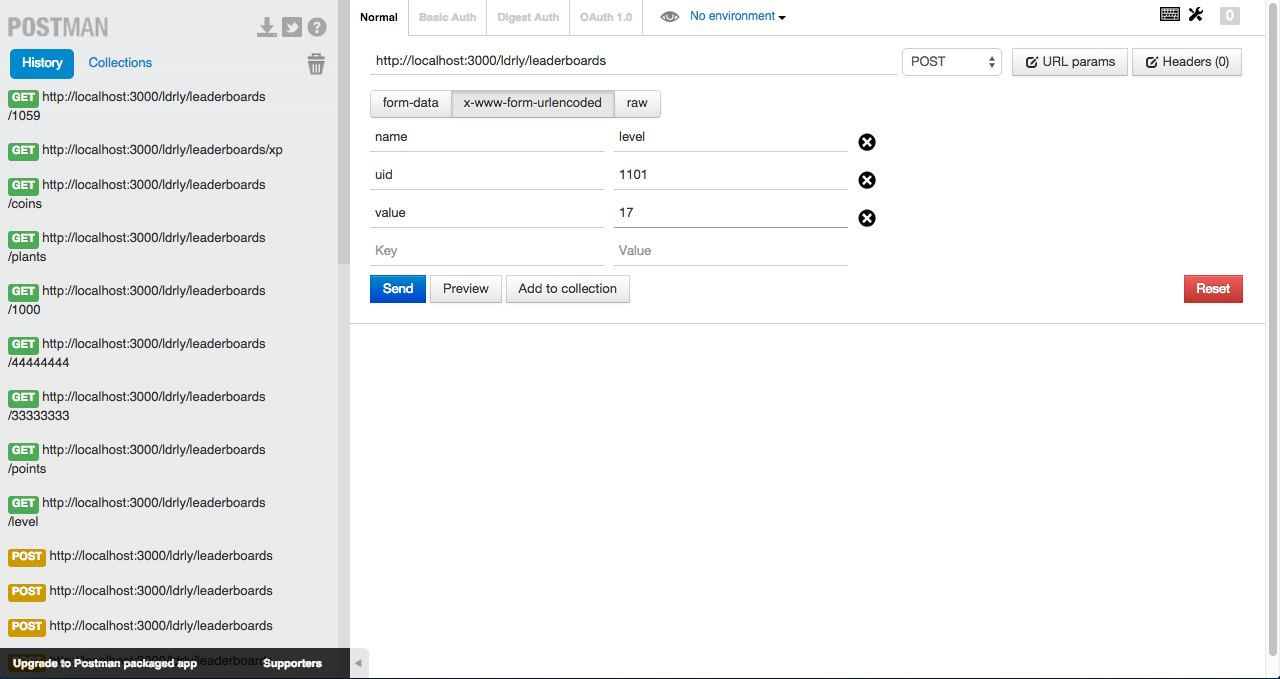Create a simple HTTP-based, RESTful API that implements following methods: sendStat, getLeaderboard, and getStats. This functionality must be implemented in using Node.js and Express, and data persisted on MongoDB. The application should check inputs to ensure validity, and requires either a success or failure message upon HTTP response to the client.
Here is an example JSON schema that could be used to persist the stats. Feel free to change or expand upon this design:
{
“_id”: ObjectId(“540de92d15f55f0c9d636d43”),
“name”: “kills”,
“uid”: 12341324,
“value”: 11,
“created_at”: ISODate(“2014-09-08T17:36:45.174Z”)
}
To simulate a real world scenario, create 100 unique usernames, each username submits 10 unique stat names (e.g. points, kills, xp, level, missions_complete, etc) with numeric points.
This project was the tech test for my LDRLY interview.
In order to run this properly, you will need:
Express version 4.12.1
Mongoose version 3.8.25
Body-Parser version 1.12.1
All of these are defined in the package.json file so all that needs to install the dependencies,
npm install
start the server,
node server.js
and find a way to send requests and receive responses. For this, I used Postman. You can find it here.
An example of the URI to which the get request would be made is:
http://localhost:3000/ldrly/leaderboards/1059
where 1059 is the user id. This gets all the stats for user 1059. You can get the leaderboards by calling:
http://localhost:3000/ldrly/leaderboards/coins
where coins is a stat. To add a stat, you can call POST with:
http://localhost:3000/ldrly/leaderboards
where the body of the request should be urlencoded and look something like this:
key: name value: level
key: uid value: 1101
key: value value: 17
This would is also a good suggestion for a POST request test due to how the model was defined (refer to assumption 1.). In Postman, the request build would look something like this:
It should be noted that possible values for stat names are as follows:
kills, points, level, missions_complete, xp, objects_collected, diamonds, coins, acres_owned, plants
The users that already exist are users with usernames between 1000 to 1100.
The database has been populated, the code is here on github, and hopefully you can use Postman to view the results of the requests. If you would like access to the database, please let me know.
I have over-simplified this, but I thought it was best to keep it as simple as possible in this context. Had this been an actual system expected to go live, I would have changed many things about
I have listed the assumptions I made because I didn't want to fill up your inbox with tons of emails asking you to clarify. I hope that is okay.
-
The stat model defined was created with the intent that it would be used for one and only one game. This implies that the stat names are unique and the user ids are unique (while there are records with the same stat names, and records with the same uid, it is simulating unique uids and stat names). As a result of this assumption, the model is very simple, and neither the user id or the stat name is defined to be unique.
-
I assumed that the terms username and user id were interchangeable, so in this model, uid refers to a user name and vice versa. This was to simplify the stat model.
-
I used Mongoose because it is a more heavy duty driver, has built in validation, and works for larger systems. I wanted to have experience with this driver because I thought it would be more useful.
-
In the description of the test, you define getLeaderboard as a function that gets a "JSON sorted list of all recorded users with entires for the specified stat (highest to lowerest) of the username, users ranking, and points scored". I understood this as follows:
a) return a JSON array
b) of stats with uid, points scored, and ranking
c) where the ranking is added to the JSON objects after the query and not persisted in the database
d) and if there are users that have the same value for the same stats, then both users will have the same rank. For instance, if I am user 1002 and I'm on level 46 and user 1059 is also on level 46, then we will have the same rank.
The server.js file contains all of the code related to the server, the invoked function definitions and other helpers.
The schema for the data is located in models/stat.js.
The test folder contains another node app that generated all of the test data and added it all to the database.
As mentioned above, the package.json file contains all of the dependencies for this app.
